What OpenOffice.org Is and What OpenOffice.org Does
| < Day Day Up > |
| OpenOffice.org is a set of integrated programs maintained by the OpenOffice.org team that you download from the OpenOffice.org Web site. Talk about name branding! Originally, a German company named StarDivision created StarOffice in the mid-1980s. Sun Microsystems purchased StarOffice in 1999 and added features, lowered the price (to free ), and changed the name to OpenOffice.org. OpenOffice.org works on the Windows, Linux, Macintosh, FreeBSD, and Solaris operating systems too. Current versions of OpenOffice.org share most features and an almost identical interface with Sun Microsystem's StarOffice package, a suite offered for sale as another alternative to Microsoft Office. NOTE
OpenOffice.org offers integrated software tools that are powerful yet easy to learn and use. Offices large and small can use OpenOffice.org “based applications for many of their day-to-day computer needs, as can families and home-based businesses that want simple but robust writing and analysis tools for their computers. With each new revision, OpenOffice.org takes you to the next step with an improved user interface and more solid features that help you become more productive in the way you use the OpenOffice.org products. The OpenOffice.org Web site is loaded with information, technical support, white papers, forums, press information, upcoming events, and manuals that give you support and background information about OpenOffice.org. NOTE
With OpenOffice.org's help, you'll get your work done better and more quickly. OpenOffice.org automates many computing chores and provides tools that work in unison and share data between them. There can be no hiding the fact that OpenOffice.org is a direct competitor to Microsoft Office. On a price/performance comparison, OpenOffice.org mangles Microsoft Office, even though Microsoft Office is more powerful than OpenOffice.org, at rare times more stable (depending on which Microsoft Office updates you've applied recently and how stable they are), and is better refined in certain tasks . For example, adjusting graphic images in a multicolumned document or on an Impress presentation isn't quite as simple as the same task in Word or PowerPoint. Yet, those fine- tuned advances in Microsoft Office come at a price, and the price is steep compared to the free OpenOffice.org system. Lots of politics exist between those in the OpenOffice.org camp and those in the Microsoft Office camp. Throughout this book, I'll do my best to display my encouragement and strong support for OpenOffice.org, its concepts, and its power. At the same time, I don't want to enter the political debate between those on the OpenOffice.org side and those on the Microsoft Office side. I see no reason why both cannot coexist, especially given the ease with which OpenOffice.org works with Microsoft Office files. The OpenOffice.org Web site dedicates itself to helping you use OpenOffice.org better. 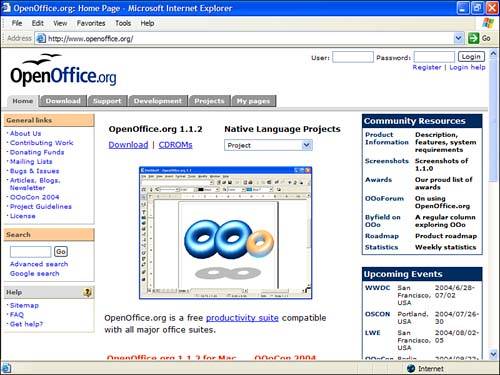 NOTE
What's in OpenOffice.org?OpenOffice.org contains the most needed applications ”a word processor, a spreadsheet program, a presentation program, a drawing program ”and more inside a single system. OpenOffice.org is designed so that its programs work well together, and although you might not need every program in OpenOffice.org, you can easily share information between any OpenOffice.org programs that you do want to use. Program collections such as OpenOffice.org are often called program suites . The following is a quick overview of the primary OpenOffice.org programs:
In addition to these four major programs, OpenOffice.org includes several other features, such as an HTML editor for Web page design and editing as well as a mathematical formula editor that you use to create complex math equations (see 30 Use Mathematical Formulas in Documents ). All the OpenOffice.org programs share common features and common menu choices. The next two figures show an Impress editing session and a Draw editing session. Even though the Impress screen shows a slide from a presentation and the Draw screen shows a flier being created, the surrounding interface elements are extremely similar. The menus , toolbars , and status bar buttons are almost identical for both programs. When you learn one OpenOffice.org program, you are well on your way to knowing quite a bit about all the other OpenOffice.org programs, too. When you design and edit presentations with Impress, you'll recognize the interface because OpenOffice.org programs share a similar interface. 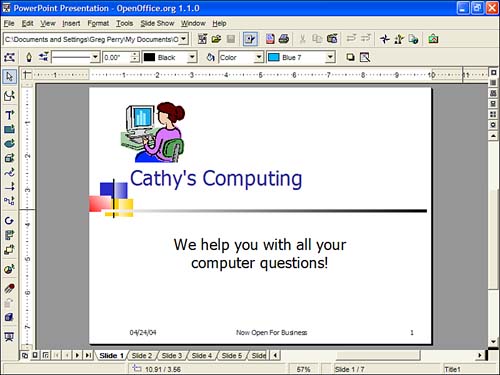 Draw's menu, toolbars, and status bar elements are virtually identical to those of other OpenOffice.org programs, especially those of Impress.  In addition to working with familiar interfaces in the OpenOffice.org products, you can insert data that you create in one program into another program within the OpenOffice.org suite. If you create a financial table with Calc, for instance, you can put the table in a Writer document that you send to your board of directors and embed the table in an Impress presentation to stockholders . Once you learn how to use any program in the OpenOffice.org suite, you will be far more comfortable using all the others because of the common interface. OpenOffice.org Is VersatileThe OpenOffice.org products are general purpose, meaning that you can customize applications to suit your needs. You can use Calc as your household budgeting program, for example, and also as your company's interactive balance-sheet system. You can integrate OpenOffice.org into your networked system. This way, OpenOffice.org provides useful features whether you are networked to an intranet, to the Internet, or to both. You can share OpenOffice.org information with others across the network. OpenOffice.org fits well within the online world by integrating Internet access throughout the OpenOffice.org suite. Introducing WriterWhen you need to write any text-based document, look no further than Writer. Writer is a word processor that supports many features, including the following:
The next figure shows a Writer editing session. Even though Writer is a word processor, you can see from the figure that it supports advanced formatting, layout, and graphics capabilities so that you can produce professional documents, covers, and title pages using Writer. Writer easily handles text, graphics, and advanced formatted layout of any document you wish to create.  Introducing CalcCalc's primary goal is to help you organize and manage financial information such as income statements, balance sheets, and forecasts. Calc is an electronic spreadsheet program that supports many features, including the following:
The following figure shows a Calc editing session. The user is entering income statement information. If you have worked with other worksheet programs, you might be surprised at how fancy Calc can get. Calc's automatic formatting capabilities make creating advanced worksheets easy. Calc helps you create, edit, and format numeric worksheets. 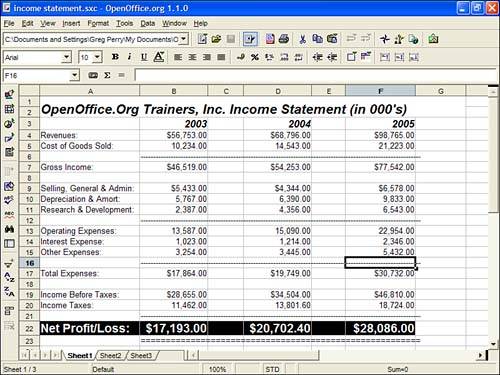 Introducing ImpressHave you ever presented a talk and longed for a better approach to messy overhead slides? Have you seen the pros wow their audiences with eye-catching, professional computerized presentations? With Impress, there is simply no reason why you shouldn't be wowing your audiences as well. Professional presentations are now within your reach. Impress supports many features, including the following:
The next figure shows an Impress editing session. The user is getting ready for a presentation and has only a few minutes to prepare six color slides for the meeting. With Impress, a few minutes are more than enough time! Introducing DrawWith Draw, you can generate drawings and graphics. Draw supports all popular graphics formats, both for importing images and for the drawings you want to save. You can create freeform drawings and you can use Draw's predesigned shapes to create more modern artwork, such as a commercial artist may require. Here are just a few features that Draw supports:
Impress helps you create, edit, and format professional presentations.  The next figure shows a Draw editing session. The drawing contains both text and graphics. Draw's ability to combine both text and graphics makes it great for businesses that need to design brochures , ads, fliers, logos, and other artwork necessary throughout the world. No Database ”Except There Is a Database!Unlike Microsoft Office's Access database, OpenOffice.org doesn't offer a separate, standalone database management program. Nevertheless, Calc includes several built-in database features, and you will be able to use Calc for a surprising amount of database work. With Draw, you can create impressive drawings and include text with them. 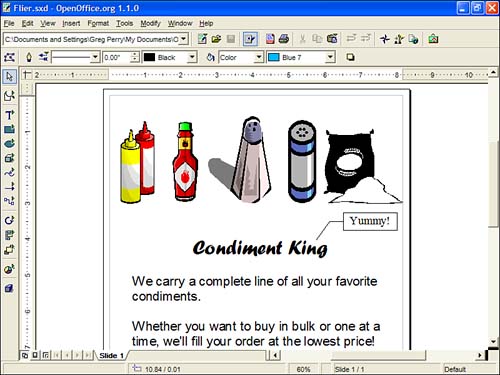 Calc's database capabilities include the following:
The next figure shows a Calc database session. As you can see, Calc can manage a lot of data. Although you see all the data here, the drop-down list boxes provide filters for you to limit the data you want to see, as well as other tools to sort and group the data in a more meaningful way, depending on your needs. Let Calc manage your database. 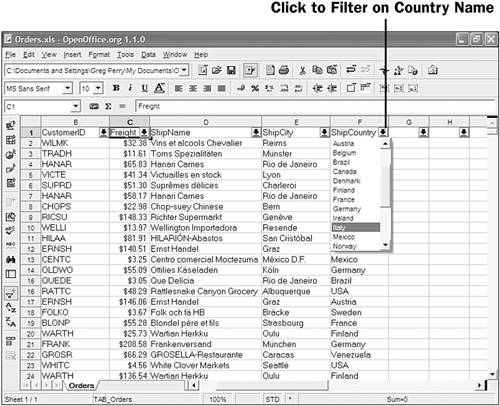 |
| < Day Day Up > |
EAN: 2147483647
Pages: 205